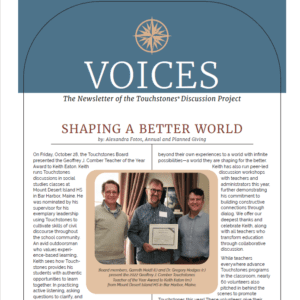
Elliot Zuckerman’s, Figuration 13 (1997), oil on canvas with charcoal.
By Olivia Braley
From late November into early December, Touchstones held an online art exhibition showcasing the dynamic work of Elliot Zuckerman. As part of this exhibition, Touchstones hosted a number of online discussions and panels featuring artists and members of the community to engage actively with Zuckerman’s work. I spoke with Stacey Turner, one of the panelists, about her experience and impression of her first Touchstones discussions. Stacey is a visual artist, former art educator, and my mother.
Our conversation began with her general impression of a Touchstones discussion group. She participated in a discussion of Elliot Zuckerman’s artwork on the first day of the exhibition, having no prior Touchstones experience. She said the conversation immediately sparked her interest; it “was thought-provoking and refreshing to interact with new people in a safe environment.” It’s not always that you get to talk about and listen to people discuss a topic meaningfully, she added. In the isolating digital world that we are currently navigating, Stacey especially appreciated the opportunity for “designated time to listen to interesting people and talk about interesting things.” Though it was her first Touchstones discussion and she didn’t know anyone in the group, she told me it was clear the people were friendly and the environment welcoming.
We spent the majority of our conversation talking about her experience being on the panel and the ways considering art this way was different from her experience as a painter herself, and as a children’s educator. She said, “I know that when I paint or even look at others’ paintings, I’m looking at them from a practical point of view—either my perspective or from the perspective of the person who created them. I’m always trying to get in the artist’s head, and that colors my interpretation of what I’m seeing.” It’s likely that all people have experiences that similarly cloud their impression of the things they encounter. However, in the Touchstones groups, these experiences meld together to deepen the discussion as a whole. Stacey noticed that “in the panel, the benefit of having thoughtful people who have different experiences in the arts, different backgrounds, and different points of views was clear. I got to express my thoughts while getting an exposure to other interpretations that gave me a fresh view from another perspective.” In having some of her perspective taken away, she could see the art differently than before.
I asked Stacey if she had any closing thoughts about the Touchstones discussions. She said, “Something that in my experience is very unique to Touchstones is the level of respect I felt. It was more than just politeness: there was a level of acceptance, tolerance, and civility that was wonderful.” She added that she felt that with Touchstones you “could bring in people with vastly opposed ideas and would still have a forum to discuss, which is very important. Most groups are not tailored in such a way that it is ever possible, much less something that can be reproduced regularly.”



 Join the
Join the